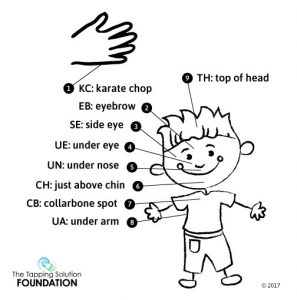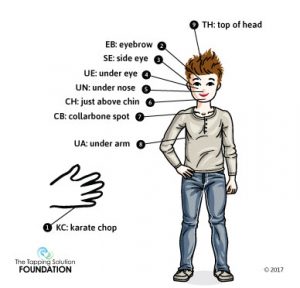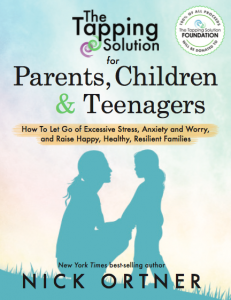
Published By: The Tapping Solution
Written By: Nick Ortner
This post contains excerpts from The Tapping Solution for Parents, Children and Teenagers.
Tapping with your Child: Depression
Children are often moody, cycling easily in and out of “the blues.” But what happens when feeling “the blues,” or even constant moodiness, becomes the norm for your child?
Depression manifests in children in different ways, but often includes a significant change, or several changes, in behavior. For instance, your once outgoing child might suddenly have no interest in playing with friends, or your physically active child may start sleeping all the time or become lethargic and irritable.
Once depression takes hold, it can quickly shift into a downward cycle that is hard to disrupt. As one example, let’s say your child starts feeling depressed and begins sleeping more. As a result she spends less time with friends, who feel rejected by her, and eventually stop inviting her along. That, in turn, makes your child feel unloved, which then adds to her depression—and just like that, the cycle self-perpetuates.
To make matters worse, just when your child most needs your love and support, s/he feels too depressed to voice his/her needs and desires.
Is My Child Depressed?
Recognizing depression in children isn’t always easy. While there are different kinds of depression, and a long list of relevant symptoms, depression is generally defined as more than being “down in the dumps.”
Sadness is often mistaken for depression, but sadness is a healthy, although unpleasant, emotional response to experiences. While sadness can lead to depressive behavior and may even last for longer periods of time, it’s a definitive emotional response to something or someone.
Unlike sadness, depression is often characterized by emotional numbness, as well as apathy, low energy and chronic moodiness.
Teenagers in particular commonly experience periods where they withdraw and may not seem like their “normal” selves. While these changes in mood and behavior can turn into long-term depression, they can also be phases that pass or smooth out naturally within a period of days or perhaps a couple of weeks.
Unlike grief, PTSD, and other challenging but normal responses to events and circumstances, depression often seems like an ongoing case of “the blues” that doesn’t have a clear cause.
While depression has been linked to the brain, it’s important also to remember that the brain is neuroplastic, meaning that it’s capable of transforming. Tapping, as well as physical exercise, wholesome nutrition, improved sleep and other positive habits support positive changes in the brain and body.
Tapping is a great way to help your child get his/her emotions and energy moving again. Before we look at how to use Tapping with a depressed child, however, we’ll begin with Tapping on the stress and worry you may feel as a result of your child’s depression.
Adult Tapping: Releasing Stress around Your Child’s Depression
Watching your child suffer with depression is painful and frustrating for parents, who want nothing more than to resolve their child’s pain and hopelessness. Before you try Tapping with your child on his/her depression, it’s important to tap on your own emotions first.
To start, notice which emotion(s) you feel most intensely when you think about your child’s depression—fear, anxiety, anger, shame? Focus on your primary emotion and give it a number of intensity on a scale of 0 to 10.
I’ll focus on fear and anxiety, but as always, focus your Tapping on your experience.
Take a deep breath, and begin by Tapping 3 times on the Karate Chop point.
Karate Chop (Repeat 3 times): Even though I’m so scared and anxious about my child’s depression, I deeply and completely love and accept myself.
Eyebrow: S/he is so depressed
Side of Eye: It’s so painful to watch
Under Eye: I’m so afraid for him/her
Under Nose: So anxious about his/her depression
Under Mouth: I need to fix this
Collarbone: But I’m not sure how
Under Arm: I don’t know if s/he will let me help
Top of Head: I’m so scared
Eyebrow: So anxious
Side of Eye: I feel so hopeless
Under Eye: I need to be able to fix this
Under Nose: I need to do something to help
Under Mouth: All this fear
Collarbone: All this anxiety
Under Arm: His/her depression
Top of Head: It’s overwhelming
Eyebrow: It’s okay to feel this way
Side of Eye: I can trust this process
Under Eye: I can relax even though things don’t seem okay right now
Under Nose: I can trust this process
Under Mouth: It’s safe to feel safe
Collarbone: It’s safe to relax now
Under Arm: Letting go of this fear and anxiety now
Top of Head: Feeling relaxed and at peace now
Take a deep breath. How intense is your primary emotion now? Keep Tapping until you get the desired relief.
You can find these tapping diagrams, along with many other free resources, by visiting our collection of parent and teacher items here.
Is My Child’s Depression My Fault?
Many loving, caring parents wonder if they’re to blame for their child’s depression. The answer is no. Depression isn’t something you wanted for your child, and not something for which you should blame yourself.
Since awareness is critical to the treatment process, it is important to know that, according to the Anxiety and Depression Association of America, children of depressed parents are at higher risk for depression themselves. That doesn’t mean that you’re at fault, however. Instead, it’s a reason to notice any depressive tendencies, as well as persistent changes in mood and/or behavior, in yourself as well as your child.
Depression can be challenging, but it is treatable. Recognizing that your child may be suffering from depression is a huge step forward. If you yourself have suffered or currently are suffering from depression, be sure to use Tapping on your own, as well.
Now that you’ve had an experience, let’s look at some of the ways that you can use Tapping to support your child in overcoming his/her depression.
Note: As always, when Tapping with your child, tailor your words to your child’s age and experience.
Child/Teenager Tapping: Shedding “The Blues”
If your child is suffering from “the blues,” s/he may seem disengaged, no longer interested in the people, places and activities that once energized her/him. Tapping can help to reignite your child’s spark, and also to give him/her insight into the deeper emotions that may be (dis)coloring his/her inner and outer worlds.
If your child is willing, have him/her rate how “blue” or “blah” s/he is feeling, either on a 0 to 10 scale or using the “this much” method of measurement.
Take a deep breath and begin by Tapping 3 times on the Karate Chop point.
Karate Chop (Repeat 3 times): Even though nothing feels good anymore, I love myself and accept how I feel.
Eyebrow: This darkness
Side of Eye: Nothing feels good anymore
Under Eye: Things are so bleak
Under Nose: Nothing feels worthwhile anymore
Under Mouth: All this darkness
Collarbone: It’s too much
Under Arm: This darkness
Top of Head: I can’t escape it
Eyebrow: This darkness
Side of Eye: I can’t shed it
Under Eye: It’s overwhelming
Under Nose: This darkness
Under Mouth: I feel it everywhere
Collarbone: It won’t go away
Under Arm: What’s this darkness really about?
Top of Head: Why won’t this darkness go away?
Eyebrow: It’s safe to feel this darkness
Side of Eye: And it’s safe to let it fade away
Under Eye: I can see what’s beneath it
Under Nose: It’s safe to feel what’s there
Under Mouth: It’s safe to see and feel it all
Collarbone: It feels big
Under Arm: But it’s not bigger than I am
Top of Head: It’s safe to let this darkness fade away now
Take a deep breath together. Check back in with your child on how intense the “blah” feels now. Keep Tapping until s/he gets the desired relief.
Can I use Tapping for…?
In The Tapping Solution for Parents, Children and Teenagers you can learn how Tapping can be used for many of your child’s needs, such as attentiveness, impulsivity, social concerns, and MANY more!
Whether your child, or student, is dealing with common social issues, school-related anxiety, or a specific diagnosis, this book will support you in understanding your role and providing specific tools to encourage success and lifelong achievement.
The best part is that with every purchase of this book, 100% of the proceeds, in perpetuity, will be donated to The Tapping Solution Foundation to continue bringing free EFT Tapping resources to schools and families, and providing trauma relief around the world.
Until next time…
Keep Tapping!
Nick Ortner
Depression can be a complex condition, and recovery is often an ongoing process. As often as s/he is willing, tap with your child on his/her emotions, experience and behavior. As always, if your child’s depression persists or worsens, seek out professional support. For a list of certified EFT professionals, visit http://thetappingsolution.com/eft-practitioners/
Facebook Comments
Blog Comments
Recent Blog Posts

Middle School Anxiety: From Overwhelm to Empowerment
Written by: Nick Ortner

Tapping into Your Child’s Depression: Shedding “The Blues”
Written by: Nick Ortner




